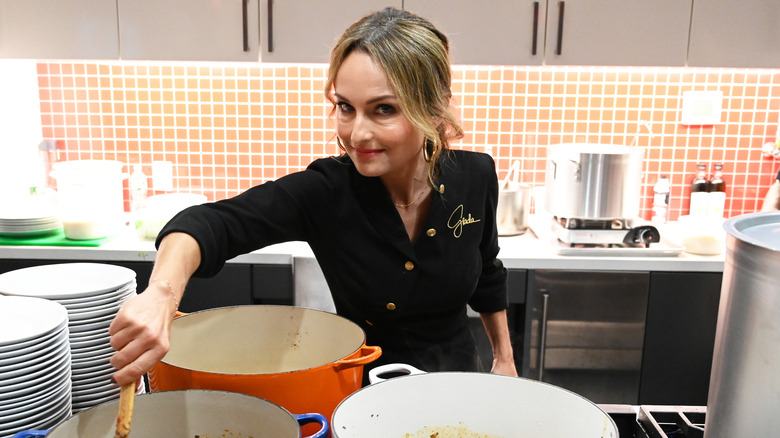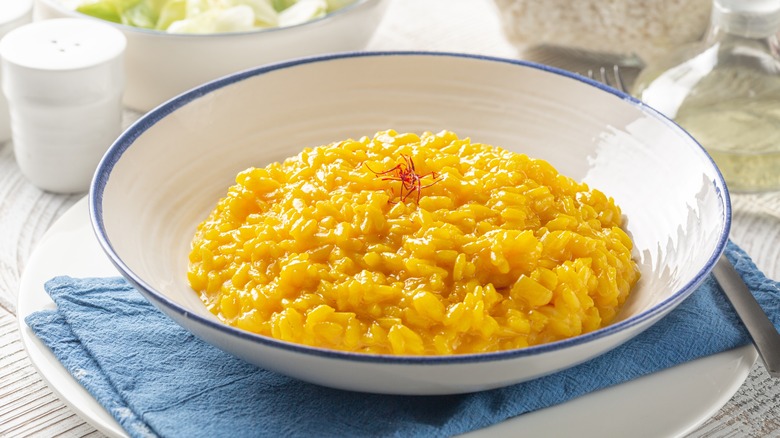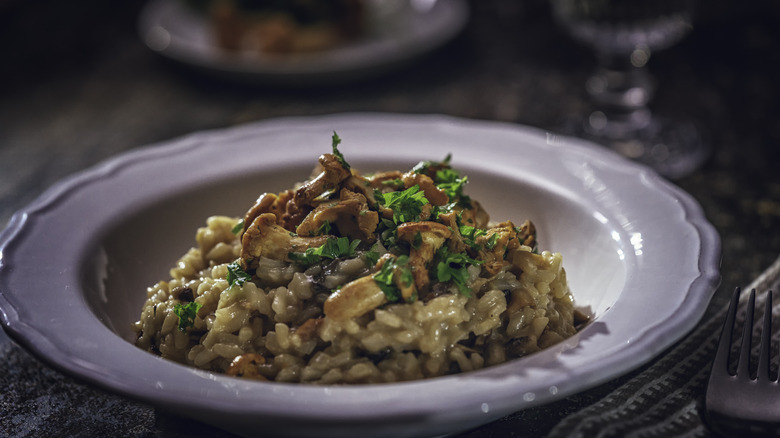Giada De Laurentiis' Favorite Rice For Making Risotto
A well-cooked risotto is a creamy delight to eat, but one that's often best enjoyed made by someone else if you hate the constant stirring. Alas, the dish doesn't have the best rep in terms of how easy it is to cook — it is known as the death dish on "Masterchef Australia," which is responsible for sending many talented cooks home. But for Giada De Laurentiis, risotto is no tricky beast to master. From using a pan with a copper base for its even heat to turning the famously complex dish into a simplified one-pot weekday dinner, De Laurentiis has plenty of advice that makes cooking risotto a breeze.
So, when the "Everyday Italian" host spills the beans on her favorite type of rice to use when making a risotto (it isn't arborio), it's perhaps a tip that fans could learn a thing or two from. Speaking to USA Today, De Laurentiis said that her go-to risotto rice happens to be aged carnaroli rice. "Aged carnaroli rice is one of the more underrated ingredients in my opinion," De Laurentiis stated, adding that it retains some tooth despite all the cooking — while still giving risotto that soft and creamy texture. This isn't the first time that the Food Network star has spoken in favor of carnaroli either — De Laurentiis also uses carnaroli in her one-pot shrimp and rice for its creaminess and ability to hold its shape!
The difference between carnaroli and arborio rice
Risotto is all about the rice, and more importantly, the starch present in it, which eventually thickens the dish and gives it a creamy texture. Rice is primarily made of two starches — amylopectin and amylose. Varieties of rice that have higher amylose remain firm when cooked, and the individual grains of rice stay separate and fluffy. On the flip side, amylopectin melts into the liquid that it is cooked in — turning it creamy with all that starch — and it keeps cooked rice soft and sticky.
Risotto requires rice that has higher amylopectin and while arborio ticks the box, carnaroli can be even better. Dubbed as the caviar or king of rice for risottos, carnaroli has amylopectin no doubt, but it also has a small amount of amylose. This means that carnaroli can bring the same thick creaminess as arborio, but it can also withstand all the cooking and stirring that goes into a risotto even better. Carnaroli will retain a bit more chew than arborio, giving it an al dente texture.
While carnaroli is generally touted as the ideal rice for risotto, De Laurentiis specifically prefers the aged variety produced by Riso Buono that's sold on Giadzy. While this brand has all the starchy creaminess typical of carnaroli, the process of aging makes it more nutrient-dense. Aged carnaroli also absorbs more liquid, which not only makes the grains more plump and firm but also means that they will have more flavor.
Other varieties of rice to use in a pinch for risotto
While De Laurentiis prefers carnaroli in her risotto, it is perfectly fine to use arborio still, especially since it is easier to find in grocery stores. That said, arborio will work much better in dishes with a shorter cooking time or in baked risottos — just make sure you know how much you can stir your risotto without ruining it. So if you do use it in a traditional risotto, you'll want to watch arborio closely as it cooks. Arborio isn't as forgiving as carnaroli and can easily overcook and turn into a goopy mess.
Vialone nano is another type of rice suitable for risotto — and is particularly popular in Venice. Though harder to find than other varieties, vialone nano is liked for its ability to plump into twice its size as it cooks, which also gives it more flavor. Vialone nano is also the preferred variety of rice for all'onda or wavy risottos — a type of risotto that hits the sweet rich and saucy spot between dry and soupy risotto, giving it the smooth appearance of ocean waves as it moves in the pan.
Carnaroli, arborio, and vialone nano aside, there are plenty of short-grain rice varieties, such as baldo and maratelli, that you can use. Even sushi rice can work if there's absolutely no other option. As long as it's not long-grain, most varieties of short-grain rice will work for risotto when you're in a pinch.



